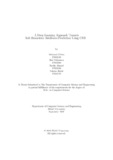| dc.contributor.advisor | Chakrabarty, Amitabha | |
| dc.contributor.author | Kibria, Maharab | |
| dc.contributor.author | Tabassum, Ilmi | |
| dc.contributor.author | Ahmed, Fardin | |
| dc.contributor.author | Habib, Nahian | |
| dc.date.accessioned | 2022-01-11T09:28:07Z | |
| dc.date.available | 2022-01-11T09:28:07Z | |
| dc.date.copyright | 2021 | |
| dc.date.issued | 2021-09 | |
| dc.identifier.other | ID 17101319 | |
| dc.identifier.other | ID 17101130 | |
| dc.identifier.other | ID 17101450 | |
| dc.identifier.other | ID 17101372 | |
| dc.identifier.uri | http://hdl.handle.net/10361/15868 | |
| dc.description | This thesis is submitted in partial fulfillment of the requirements for the degree of Bachelor of Science in Computer Science and Engineering, 2021. | en_US |
| dc.description | Cataloged from PDF version of thesis. | |
| dc.description | Includes bibliographical references (pages 31-32). | |
| dc.description.abstract | Any physical, behavioural or adhered human characteristics that we can observe
from a person is known as Soft Biometric.The most common physical soft biometric
attributes are height, age, ethnicity, facial hairs, gender, hair color etc. In this era of
machine and deep learning, retrieving a person based on these semantic descriptions
has become a major research interest. Face recognition and bounding boxes are now
common implementations in IoT and surveillance systems because of the efficiency
of training models. But the research on soft biometric attributes training models
still lacks an amount. To overcome this, we have trained different CNN models
for the best outcoming prediction result with a UTKface dataset. The dataset
includes height, age and gender and 48x48 text pixels face images. The models
include CNN, Multi-Headed CNN, DenseNet-169, Multi Label CNN and ResNet-
50. After training all the models we have found that the DenseNet-169 model can
achieve the most accuracy for all the soft biometric classes in our dataset. The
accuracy we have achieved with our model is 96.16% for age, 97.74% for ethnicity
and 99.2% for age on our UTKface dataset keeping a training loss below 0.1 for
the three soft-biometric traits. All the models have been trained into the same
environment and it is being uploaded with the source code to the given link below:
https://github.com/Kibria10/machine-learning-works. | en_US |
| dc.description.statementofresponsibility | Maharab Kibria | |
| dc.description.statementofresponsibility | Ilmi Tabassum | |
| dc.description.statementofresponsibility | Fardin Ahmed | |
| dc.description.statementofresponsibility | Nahian Habib | |
| dc.format.extent | 32 pages | |
| dc.language.iso | en | en_US |
| dc.publisher | Brac University | en_US |
| dc.rights | Brac University theses are protected by copyright. They may be viewed from this source for any purpose, but reproduction or distribution in any format is prohibited without written permission. | |
| dc.subject | Deep learning | en_US |
| dc.subject | Prediction | en_US |
| dc.subject | Soft biometrics | en_US |
| dc.subject | UTKface dataset | en_US |
| dc.subject | CNN | en_US |
| dc.subject | DenseNet-169 | en_US |
| dc.subject | Multi label CNN | en_US |
| dc.subject.lcsh | Machine learning | |
| dc.subject.lcsh | Cognitive learning theory (Deep learning) | |
| dc.title | A deep learning approach towards soft biometrics attributes prediction using CNN | en_US |
| dc.type | Thesis | en_US |
| dc.contributor.department | Department of Computer Science and Engineering, Brac University | |
| dc.description.degree | B. Computer Science | |

